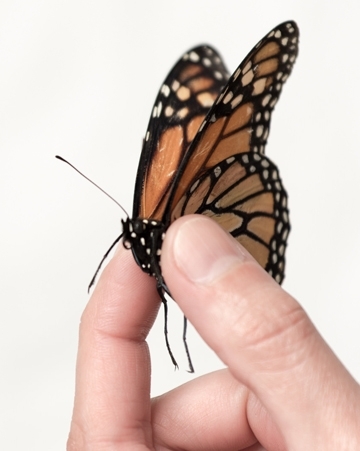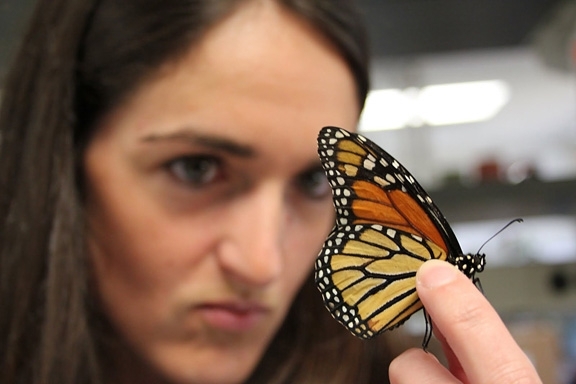
Yes, they do, says a Texas A&M researcher.
Christine Merlin, an assistant professor in Texas A&M's Department of Biology, will discuss her research on "The Monarch Butterfly Circadian Clock: from Clockwork Mechanisms to Control of Seasonal Migration" when she presents a seminar on Wednesday afternoon, May 31 at the University of California, Davis.
The seminar is set from 4:10 p.m. to 5 p.m. in Room 122 of Briggs Hall.
"The eastern North American monarch butterfly (Danaus plexippus) has emerged as a powerful model system to study animal circadian clocks and their role in an unconventional output, the photoperiod-induced long-distance migration," Merlin writes in her abstract. "Circadian clocks are endogenous 24-hour timekeepers that coordinate nearly all of the animal physiology and behavior to its environment to tune specific activities at the most advantageous time of the day. Monarchs use a circadian clock to navigate to their overwintering sites during their seasonal long-distance migration."
"The clock time-compensates for the movement of the sun across the sky over the course of the day and regulates the sun compass output in the brain. Circadian clocks could also be used to time the monarch seasonal departure from their breeding grounds, and consequently regulate the genetic/epigenetic program controlling migratory physiology and behavior. I will discuss progress that our lab has made in developing reverse-genetics in the monarch butterfly to unlock its potential as a genetic model system to study animal clockwork mechanisms and the involvement of the circadian clock in insect photoperiodic responses."
Merlin will be hosted by molecular geneticist Joanna Chiu, associate professor and vice chair, UC Davis Department of Entomology and Nematology, who is also involved in circadian-clock research. The weekly seminars, chaired by assistant professor Christian Nansen, are open to all interested persons. Plans call for recording the seminar for later posting on UCTV.
A native of France, Merlin received her bachelor's, master's and doctoral degrees majoring in animal biology, invertebrate physiology and insect physiology, respectively, at the University Paris 6 Pierre and Marie Curie in France. She accepted a postdoctoral fellowship at the University of Massachusetts in 2007.
From her post at Texas A&M University, located at College Station, 90 miles northwest of Houston, Merlin enjoys a front-row seat for the monarch butterfly migration.
She sees them heading to Mexico to overwinter, and she sees them returning.
But it's the science that drives her.
In a Texas A&M news story, Vimal Patel described her as trying to unravel "the mysteries of the migration and the role of internal clocks in the process."
"It's incredible how such a fragile insect can complete a long-range migration so demanding," Merlin told Patel. "Every piece of it fascinates me, from how it occurs to why they go precisely where they go."
An excerpt from Patel's piece:
"While she was a postdoctoral researcher at the University of Massachusetts Medical School in the laboratory of Prof. Steven Reppert, Merlin and colleagues showed that the clocks necessary for flight orientation lie in the creatures' antennae --a departure from the previous conventional wisdom that the brain controlled the mechanism, given that it controls behavioral rhythmicity in virtually every other animal, including humans.
"The conclusion stemmed from Merlin's and her co-workers' collective curiosity concerning a decades-old anecdote. Around 50 years ago, entomologist Fred Urquhart found that Monarchs became disoriented after he clipped off their antennae. Since then, it had remained just a suspicion until the Massachusetts team confirmed it with more rigorous research."
"The team's experiment exploited technology in a way Urquhart, who merely observed the Monarchs in flight, could not at the time. They used a plastic barrel-like device called a Mouritsen-Frost flight simulator in which a butterfly is connected by tungsten wire to an output system that indicates which direction it is flying. The results were clear: The antennae-less Monarchs flew in every which direction, while those with intact antennae flew southwesterly, the migratory direction."
Merlin points out that "Migration begins every year in the fall, when the day lengths change. The shortened day lengths might be a cue for the monarchs to start their migration. And if we can show this is the case and that the circadian clock is involved, we can now start to understand the genetic program that is allowing the migratory behavior."
Attached Images:
